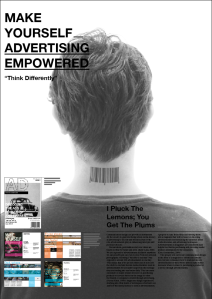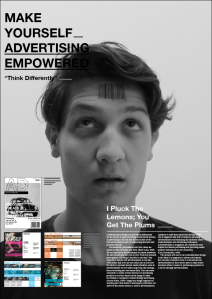Monthly Archives: May 2013
Bottled water vs Tap water 20/20
“Everest”water from Texas
“Aquafina” water from Detroit river
Bottled waters tasting the same or worst than tap water, but due to advertising unfair manipulation, consumers are lead to purchasing these products when they can get it for free.
Bottled water bad for you?
http://www.stuff.co.nz/life-style/wellbeing/8695222/Is-bottled-water-bad-for-you
“Chris Winder, professor of toxicology at the Australian Catholic University, says the only well-established risk from reuse of plastic bottles is bacterial contamination.”
“One litre of bottled water costs up to 1500 times more than one litre of tap water and in New Zealand we have the luxury of good-quality tap water, yet bottled water sales have been a marketing success story”
Quotes
Klein, Naomi. (1999) No Logo, Picador.
“What these companies produced primarily were not things, they said, but images of their brands. Their real work lay not in manufacturing but in marketing.” (Pg. 4)
“… there were those in the industry who understood that advertising wasn’t just scientific; it was also spiritual.” (Pg. 6)
“… advertising spending was more than just a sales strategy: it was an investment in cold had equity. The more you spend, the more your company is worth.”
(Pg. 8)
Du Plessis, Erik. (2005) The Advertised Mind: ground-breaking insight into how our brain respond to advertising, Kogan page publisher.
“… consumers absorb something from the advertisement, perhaps without consciously thinking much, if at all, about it at the time.” (Pg.7)
“For an advertisement to be noticed and remembered is in itself not sufficient. It also has to shape consumers’ buying behaviour, and in order to ensure that it does so, we need to pay attention both to the connection between the advertisement and the brand, and to the buying process, and the role of memory within it.” (Pg.107)
Lasn, Kalle. (2000) Culture Jam: how to reverse America’s suicidal consumer binge – and why we must, Harper Collins.
“Our role is mostly to listen and watch – and then, based on what we have heard and seen, to buy.” (Pg. introduction)
“We are being manipulated in the most insidious way. Our emotions, personalities and core values are under siege from media and cultural forces too complex to decode.” (Pg. introduction)
“Living inside the postmodern spectacle has changed people. Figuratively, most of us spend the majority of our time in some ethereal place created from fantasy and want. After a while, the hyperreality of this place comes to seem normal.” (Pg. 7)
“… “mental pollution” – nonchalantly absorbing massive daily doses of it without a second thought. Our mental environment is a common property resource like the air or the water. We need to protect ourselves from unwanted incursions into it, …” (Pg.13)
“We long ago learned to watch what we dump into nature or absorb into our bodies; now we need to be equally careful about what we take into our minds.” (Pg. 13)
“Advertisements are the most prevalent and toxic of the mental pollutants. From the moment your radio alarm sounds in the morning to the wee hours of late night TV, micro jolts of commercial pollution flood into your brain at the rate of about three thousand marketing messages per day.” (Pg. 19)
“Corporate advertising (or is it the commercial media?) is the largest single psychological project ever undertaken by the human race. Yet for all of that, it’s impact on us remains unknown and largely ignored.” (Pg. 19)
Holbrook, Morris B. (Jul, 1987) Journal of Marketing, Vol. 51, No. 3: Mirror, mirror, on the wall, what’s unfair in the reflections of Advertising?, American Marketing Association.
“… Advertising’s most fundamental impact may be that it induces people to keep productive in order to keep consuming, to work in order to buy…” (Pg. 97)
Bottled Water
http://science.howstuffworks.com/environmental/green-science/bottled-water.htm
Bottled waters are somewhere where we can see the advertising unfair manipulating take place.
Bottled waters are apparently not as health and clean as they are advertised and persuaded to be.
The sales of the bottled waters are from the image and the value that was created through manipulation and persuasion through advertising.
Poster Presentation feedback
- Good Idea and concept
- Need to look into how else I can deliver this project
- Is people interested?
- How can I get people interested.
- What can lead the people into this project.
Poster (concept and development)
The poster consists of main image representation of under sieged, manipulated consumers. The title and the subtitles are based from some of the media literacy used from well known advertisements. “Make Yourself…” is media literacy used from Nike advertisement to persuade the consumers. The “Think differently” was a slogan that was used by Apple computers back in 1997 and “I pluck the lemons; you get the plums.” is media literacy used from a “Lemon” advertisement from Volkswagen in 1960.
Abstract developed
Communication design can provide an instrument for the society to gain knowledge about media literacy in advertising to decode and become aware of the role advertisements play in influencing lifestyles and purchase choices.
Us as consumers are making invalid lifestyle and purchasing choices based on the image or value the brand or company creates through advertising. (Naomi Klein, 1999) We are exposed to advertisements everyday in almost anywhere our eyes can possibly come to rest. From my personal recording I was able to see that I was exposed to over 200 advertisements in just one day. Our emotions, personalities and core values are created on what we have heard or seen. (Kalle Lasn, 2000) This means that if we are not aware and do not have the skills to read and decode media literature and techniques used in advertisements, we are under siege from all the manipulations and persuasions they feed into our brains daily. I began my design response by studying into what kinds of techniques advertisers use and how media literature is being used in advertisements to manipulate and persuade consumers.
I propose to take these ideas and develop them into form of a magazine that will be centered on decoding advertisements and educating the consumers about media literature and advertising techniques. Advertisements in magazines are considered to be one of the most helpful tools before purchasing and providing useful product information for the consumers. (Guy Consterdine, 2009) Therefore by providing the consumers with a magazine that is based in decoding advertisements, can deliver the right knowledge they need in its context.
This project sets out to use communication design in the form of a magazine to inform and educate the everyday consumers how to read and decode advertisements. This will allow the educated consumers to make better decisions when it comes to purchasing and lifestyle choices introduced from advertising.
Abstract
Communication design can provide an instrument for the society to gain knowledge about media literacy in advertising to decode and become aware of the role advertisements play in influencing lifestyles and purchase choices.
Our emotions, personalities and core values are based on what we heard and seen. (Kalle Lasn, 2000) We are exposed to advertisements in almost anywhere we can possibly put our eyes to rest. From my personal photographic recording I was able to see that I was exposed to over 200 advertisements in one day. This means that if we are not aware and do not have the skills to read and decode media literature used in advertisements we are under siege from the message they are feeding into our brains daily. This can cause consumers to make invalid decisions on purchasing products or services based on the image or value the brands or companies created through advertising. (Naomi Klein, 1999) I began my design response by studying into what kinds of techniques advertisers use and how the media literacy is used in advertisements.
I propose to take these ideas and develop them into a magazine that will be based on decoding advertisements and educating the audience about media literature and advertising techniques. Advertisements in magazines are considered most helpful tool before purchasing and providing useful product information for the consumers. (Guy Consterdine, 2009)
This project sets out to use communication design in the form of a magazine to inform and educate the everyday consumers how to read and decode advertisements so they will be able to make better decisions when it comes to purchasing a product or a service through advertisements.










Recent Comments